Results
-
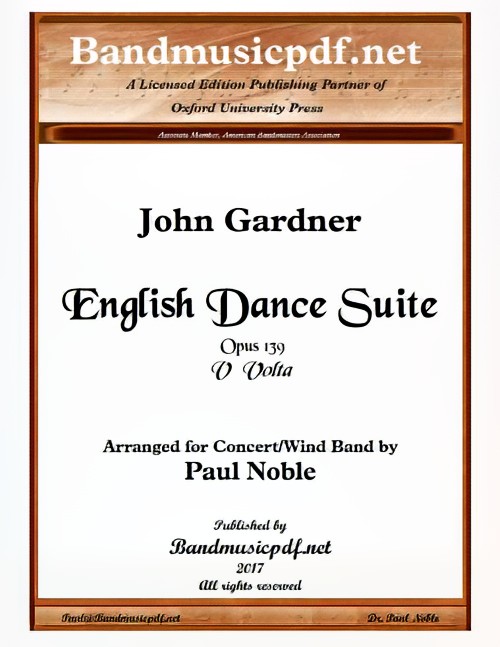 £75.00
£75.00English Dance Suite - V. Volta (Concert Band - Score and Parts) - Gardner, John - Noble, Paul
Arranged for the modern Concert/Wind Band, scored for three trumpets, reasonable doubling of parts where the original musical effect is not altered so that players can have a more responsible and enjoyable experience, more legible parts with less doubling on one staff, etc. The piece is offered either as a complete suite of seven movements, and also as seven individual movements which may be purchased independently. The English Dance Suite was originally composed by John Gardner for Wind Band, and has been re-set for the modern Concert Band instrumentation. Both the original version, edited and type-set by Paul Noble, and this arrangement are first editions now available for purchase to bands around the world. The set of seven Renaissance dances depict John Gardner's love of Scottish music, the Renaissance heritage, and some of his own mischievous approach to music. The first movement, Chacony on a Golden Theme, reminiscent of the Allegro movement of Purcell's Golden Sonata, is much used as a vehicle for variation on a repeated short harmonic progression, often involving a fairly short repetitive bass-line which offered a compositional outline for variation, decoration, figuration and melodic invention. In this it closely resembles the passacaglia. The Alman originated in the 16th century as a duple metere dance of moderate tempo, already considered very old, with a characteristic double-knocking upbeat of one or occasionally three sixteenth notes. It appears to have derived from a German dance but no identifiable dance and no German dance instructions from this era survive. The Hornpipe, usually in 3/2 dance rhythm, is an Irish, Scottish and English dance. It is done in hard shoes, which are used to help keep track of how the dancer keeps in time. There are two variations of the hornpipe dance: fast and slow. Usually, more experienced dancers will do the slow hornpipe but younger dancers will start out with the fast hornpipe and then switch in later years. The Corranto is a 16th-century court dance characterized by short advances and retreats, in quick triple time. The Volta (Italian: the turn or turning) is an anglicised name from the later Renaissance. Its main figure consisted of a turn and lift in a sort of closed position. The Pavan is a slow processional dance common in Europe during the 16th century. The Reel, indigenous to Scotland, consists largely of quaver (eighth note) movement with an accent on the first and third beats of the bar.
Estimated dispatch 7-14 working days
-
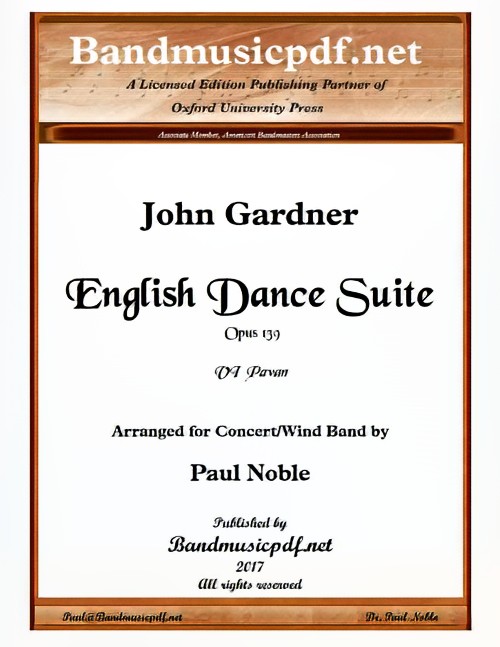 £75.00
£75.00English Dance Suite - VI. Pavan (Concert Band - Score and Parts) - Gardner, John - Noble, Paul
Arranged for the modern Concert/Wind Band, scored for three trumpets, reasonable doubling of parts where the original musical effect is not altered so that players can have a more responsible and enjoyable experience, more legible parts with less doubling on one staff, etc. The piece is offered either as a complete suite of seven movements, and also as seven individual movements which may be purchased independently. The English Dance Suite was originally composed by John Gardner for Wind Band, and has been re-set for the modern Concert Band instrumentation. Both the original version, edited and type-set by Paul Noble, and this arrangement are first editions now available for purchase to bands around the world. The set of seven Renaissance dances depict John Gardner's love of Scottish music, the Renaissance heritage, and some of his own mischievous approach to music. The first movement, Chacony on a Golden Theme, reminiscent of the Allegro movement of Purcell's Golden Sonata, is much used as a vehicle for variation on a repeated short harmonic progression, often involving a fairly short repetitive bass-line which offered a compositional outline for variation, decoration, figuration and melodic invention. In this it closely resembles the passacaglia. The Alman originated in the 16th century as a duple metere dance of moderate tempo, already considered very old, with a characteristic double-knocking upbeat of one or occasionally three sixteenth notes. It appears to have derived from a German dance but no identifiable dance and no German dance instructions from this era survive. The Hornpipe, usually in 3/2 dance rhythm, is an Irish, Scottish and English dance. It is done in hard shoes, which are used to help keep track of how the dancer keeps in time. There are two variations of the hornpipe dance: fast and slow. Usually, more experienced dancers will do the slow hornpipe but younger dancers will start out with the fast hornpipe and then switch in later years. The Corranto is a 16th-century court dance characterized by short advances and retreats, in quick triple time. The Volta (Italian: the turn or turning) is an anglicised name from the later Renaissance. Its main figure consisted of a turn and lift in a sort of closed position. The Pavan is a slow processional dance common in Europe during the 16th century. The Reel, indigenous to Scotland, consists largely of quaver (eighth note) movement with an accent on the first and third beats of the bar.
Estimated dispatch 7-14 working days
-
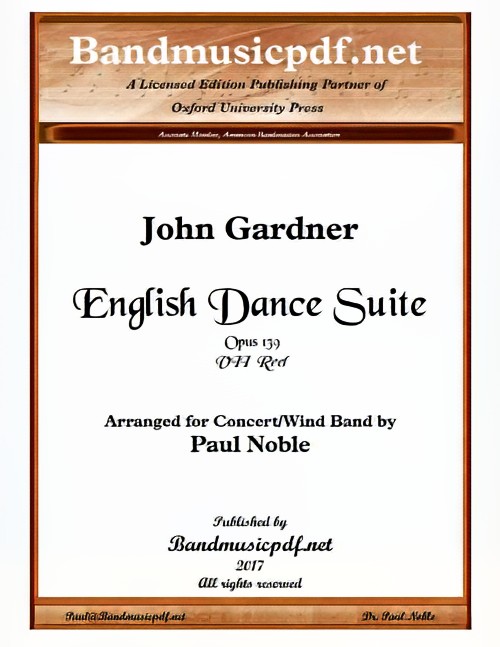 £125.00
£125.00English Dance Suite - VII. Reel (Concert Band - Score and Parts) - Gardner, John - Noble, Paul
Arranged for the modern Concert/Wind Band, scored for three trumpets, reasonable doubling of parts where the original musical effect is not altered so that players can have a more responsible and enjoyable experience, more legible parts with less doubling on one staff, etc. The piece is offered either as a complete suite of seven movements, and also as seven individual movements which may be purchased independently. The English Dance Suite was originally composed by John Gardner for Wind Band, and has been re-set for the modern Concert Band instrumentation. Both the original version, edited and type-set by Paul Noble, and this arrangement are first editions now available for purchase to bands around the world. The set of seven Renaissance dances depict John Gardner's love of Scottish music, the Renaissance heritage, and some of his own mischievous approach to music. The first movement, Chacony on a Golden Theme, reminiscent of the Allegro movement of Purcell's Golden Sonata, is much used as a vehicle for variation on a repeated short harmonic progression, often involving a fairly short repetitive bass-line which offered a compositional outline for variation, decoration, figuration and melodic invention. In this it closely resembles the passacaglia. The Alman originated in the 16th century as a duple metere dance of moderate tempo, already considered very old, with a characteristic double-knocking upbeat of one or occasionally three sixteenth notes. It appears to have derived from a German dance but no identifiable dance and no German dance instructions from this era survive. The Hornpipe, usually in 3/2 dance rhythm, is an Irish, Scottish and English dance. It is done in hard shoes, which are used to help keep track of how the dancer keeps in time. There are two variations of the hornpipe dance: fast and slow. Usually, more experienced dancers will do the slow hornpipe but younger dancers will start out with the fast hornpipe and then switch in later years. The Corranto is a 16th-century court dance characterized by short advances and retreats, in quick triple time. The Volta (Italian: the turn or turning) is an anglicised name from the later Renaissance. Its main figure consisted of a turn and lift in a sort of closed position. The Pavan is a slow processional dance common in Europe during the 16th century. The Reel, indigenous to Scotland, consists largely of quaver (eighth note) movement with an accent on the first and third beats of the bar.
Estimated dispatch 7-14 working days
-
 £94.99
£94.99Children's Oak (Concert Band - Score and Parts) - Deleruyelle, Thierry
Children's Oak was commissioned by the wind band from Beauquesne, France. This solemn work pays homage to a city particularly affected by the two World Wars and is inspired by the knowledge that the city of Beauquesne needed to recover from these terrible episodes in its history. The title has its origin in the roots of the word "Beauquesne", the beautiful oak tree. It is a beautiful slow piece for your concert, or as a resource to work on phrasing and intonation, or alternatively as a warm up piece. Duration: 5.00
Estimated dispatch 7-14 working days
-
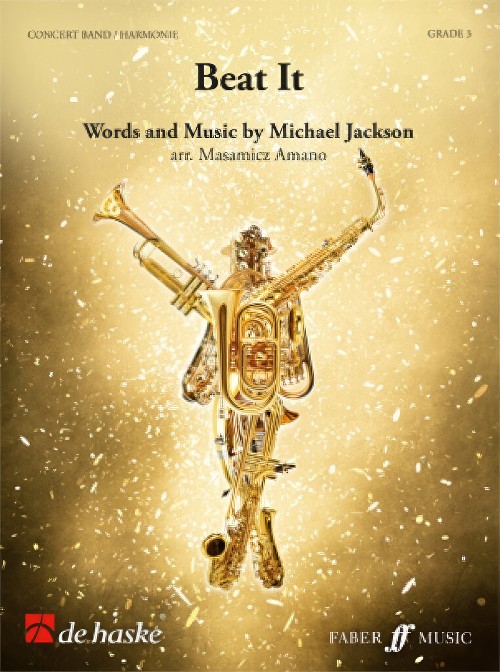 £94.99
£94.99Beat it (Concert Band - Score and Parts) - Jackson, Michael - Amano, Masamicz
Beat It, is one of Michael Jackson's most popular songs, awarded two Grammys for its commercial success. Seen by many as a rock song, Beat It was ranked by Rolling Stone magazine as one of the "100 Greatest Guitar Songs of All Time." Since its release, the song has been covered and famously reinterpreted by artists such as Fall Out Boy, Fergie and most recently Masamicz Amano, who has made this wonderful arrangement for concert band!Duration: 4:15
Estimated dispatch 7-14 working days
-
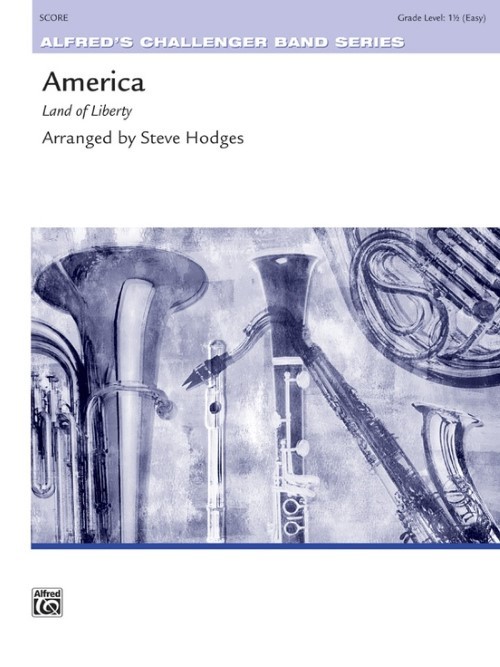 £46.95
£46.95America (Land of Liberty) (Concert Band - Score and Parts) - Hodges, Steve
Beginning with a strong introduction by the trumpets, this arrangement provides three effective settings of America. The first two settings are at a moderate march tempo in 4/4 time featuring the clarinets and trumpets, followed by a lush presentation by the low brass and woodwinds. A lively flute countermelody accompanies the first setting. The final presentation begins with a brass chorale in the traditional 3/4 meter that leads to a stirring conclusion featuring a flowing woodwind countermelody. A short rallentando leads to a spirited return of the original march countermelody that brings the piece to an exciting conclusion. Duration: 2.30
Estimated dispatch 7-14 working days
-
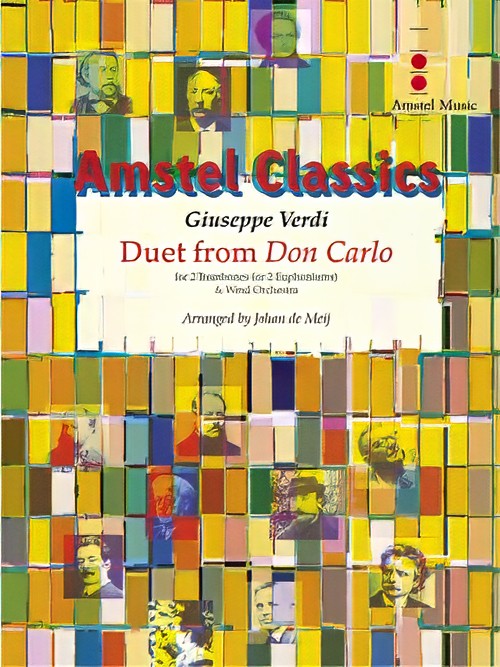 £115.00
£115.00Duet from Don Carlo (Trombone or Euphonium Duet with Concert Band - Score and Parts) - Verdi, Giuseppe - De Meij, Johan
Don Carlo was originally written (title Don Carlos) as a French five-actor for the 1867 world exhibition in Paris. Later, Verdi transformed this improant grand opera into a four-acter in Italian. With its many leitmotifs, Don Carlo was 'too Wagnerian' according to French critics, although Verdi hardly knew the music by his German colleage. For the record, the composer was not happy either with the 'lifeless and cold' performance in Paris, and the drama, concerning Charles V, Philip II and crown price Don Carlo, found its way to La Scala only twenty years later. This duet, arranged by Johan de Meij, originates from the second act. While monks pray for the soul of Emperor Charles V, his grandson Don Carlo takes the stage, tormented by the fact that the woman he loves is now married to his father. Carlo's friend Rodrigo, the Margquis of Posa, has just returned from Flanders. He asks crown prince Carlo to help him ease the oppression and suffering of the Flemish people. Carlo reveals his secret: he is in love with his stepmother. Rodrigo advises him to leave Spain and to go to Flanders. The two men vow to be friends forever in the duet Dio, che nell' alma infondere (God, who wishes to instil love and hope in our souls). Duration: 4.00
Estimated dispatch 7-14 working days
-
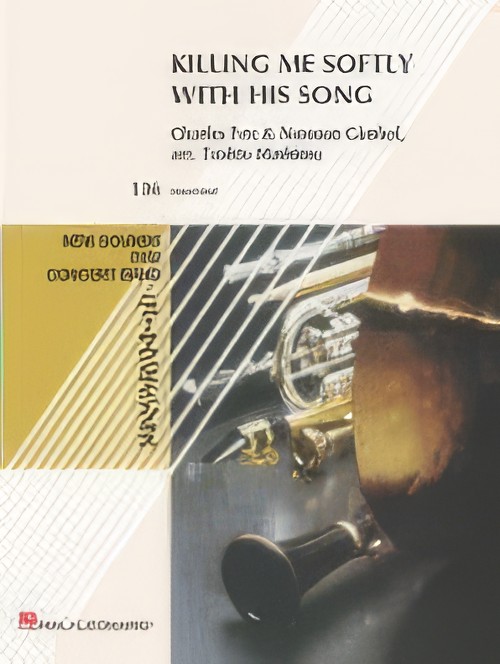 £104.99
£104.99Killing Me Softly with His Song (Concert Band - Score and Parts) - Fox & Gimbel - Mashima, Toshio
The tender ballad Killing Me Softly with His Song was written by Charles Fox and Norman Gimbel in 1971, for the American singer Lori Lieberman. She was very impressed with a performance by the then still unknown Don McLean in the Troubadour in Los Angeles. The feelings described in the lyrics are indeed those of Lieberman, but the one who, two years later, made the song world-famous was Roberta Flack. Her version won as many as three Grammy Awards. Since then, Killing Me Softly has been performed by numerous artists, including Herb Alpert, Frank Sinatra, Aretha Franklin, Anne Murray, Luther Vandross, and the Fugees.Duration: 4:00
Estimated dispatch 7-14 working days
-
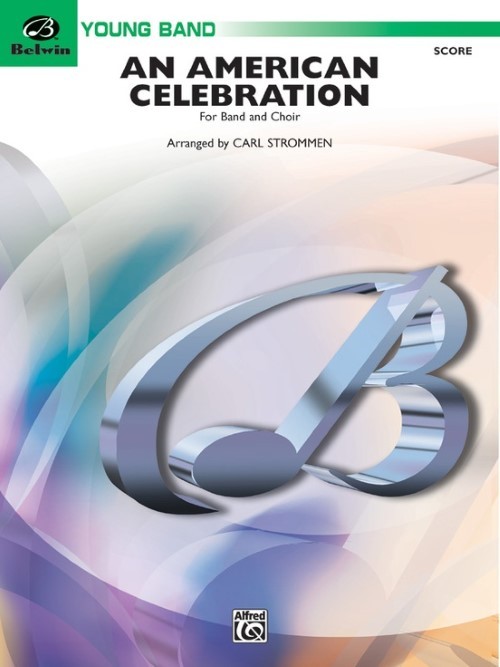 £58.50
£58.50An American Celebration (Concert Band with Optional Choir - Score and Parts) - Strommen, Carl
This medley was composed for the combination of your two- or three-part choir and your young band. The instrumental part can be performed by intermediate bands or by more advanced ensembles with limited rehearsal, while not appearing transparent. The choral parts are sold separately (SVM01082) and are attainable by intermediate level performers through high school. A great addition to the patriotic literature, this medley includes "America the Beautiful," "When Johnny Comes Marching Home," "Yankee Doodle," "The Battle Hymn of the Republic," "You're a Grand Old Flag," and "America." The instrumental transitions significantly contribute to the musical effect and offer an opportunity for the ensemble to perform as well as provide vocal accompaniment. An absolute must for all of your patriotic performance needs. Duration: 5.30
Estimated dispatch 7-14 working days
-
 £48.95
£48.95Echoes of Christmas (Concert Band - Score and Parts) - Black, Dave
Echoes of Christmas combines two Christmas favourites, While by My Sheep (or The Echo Carol) and God Rest Ye Merry, Gentlemen. The Echo Carol, so named because it is written in a call and response format, is presented here with initial statement by the brass which are then immediately echoed by the woodwinds. God Rest Ye Merry, Gentlemen features a canonic treatment of this holiday favorite, first in the flutes and clarinets and then the entire ensemble. Your audience will be echoing these Christmas carols long after your next holiday concert is over! Duration: 3.00
Estimated dispatch 7-14 working days
